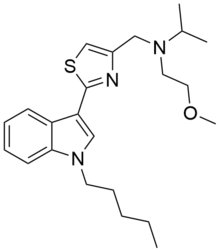Content deleted Content added
mNo edit summary |
JCW-CleanerBot (talk | contribs) |
||
| Line 13: | Line 13: | ||
| legal_US = |
| legal_US = |
||
| legal_status = |
| legal_status = |
||
| routes_of_administration = |
| routes_of_administration = |
||
<!--Pharmacokinetic data--> |
<!--Pharmacokinetic data--> |
||
| Line 20: | Line 20: | ||
| metabolism = |
| metabolism = |
||
| elimination_half-life = |
| elimination_half-life = |
||
| excretion = |
| excretion = |
||
<!--Identifiers--> |
<!--Identifiers--> |
||
| Line 40: | Line 40: | ||
}} |
}} |
||
'''PTI-2''' is an [[indole]]-based [[synthetic cannabinoid]].<ref>{{cite web | url=https://www.caymanchem.com/app/template/Product.vm/catalog/9001950 | title=PTI-2 | publisher=Cayman Chemical | accessdate=8 July 2015}}</ref> It is one of few [[synthetic cannabinoid |
'''PTI-2''' is an [[indole]]-based [[synthetic cannabinoid]].<ref>{{cite web | url=https://www.caymanchem.com/app/template/Product.vm/catalog/9001950 | title=PTI-2 | publisher=Cayman Chemical | accessdate=8 July 2015}}</ref> It is one of few [[synthetic cannabinoid]]s containing a [[thiazole]] group and is closely related to [[PTI-1]]. These compounds may be viewed as simplified analogues of indole-3-heterocycle compounds originally developed by [[Organon International|Organon]] and subsequently further researched by [[Merck & Co.|Merck]].<ref>[http://www.google.com/patents/US7700634 Julia Adam-Worrall, et al. (Indol-3-yl) heterocycle derivatives as agonists of the cannabinoid CB1 receptor. Patent US 7700634, priority date 5 March 2004]</ref><ref>[http://www.google.com/patents/US7763732 Paul David Ratcliffe, et al. Indole Derivatives. Patent US 7763732, priority date 24 August 2005]</ref><ref>[https://patentscope.wipo.int/search/en/detail.jsf?docId=WO2008101995 Julia Adam, et al. Indole Derivatives. Patent WO 2008/101995, priority date 22 February 2007]</ref><ref>Takao Kiyoi, et al. Discovery of potent and orally bioavailable heterocycle-based cannabinoid CB1 receptor agonists. ''Bioorganic & Medicinal Chemistry Letters'' 2011; 21(6):1748-1753. doi: 10.1016/j.bmcl.2011.01.082</ref> |
||
==See also== |
==See also== |
||
| Line 58: | Line 58: | ||
[[Category:Cannabinoids]] |
[[Category:Cannabinoids]] |
||
[[Category:Designer drugs]] |
[[Category:Designer drugs]] |
||
{{cannabinoid-stub}} |
{{cannabinoid-stub}} |
||
Revision as of 01:56, 14 November 2017
 | |
| Legal status | |
|---|---|
| Legal status |
|
| Identifiers | |
| |
| CAS Number | |
| ChemSpider | |
| UNII | |
| Chemical and physical data | |
| Formula | C23H33N3OS |
| Molar mass | 399.60 g/mol g·mol−1 |
| 3D model (JSmol) | |
| |
| |
PTI-2 is an indole-based synthetic cannabinoid.[1] It is one of few synthetic cannabinoids containing a thiazole group and is closely related to PTI-1. These compounds may be viewed as simplified analogues of indole-3-heterocycle compounds originally developed by Organon and subsequently further researched by Merck.[2][3][4][5]
See also
References
- ^ "PTI-2". Cayman Chemical. Retrieved 8 July 2015.
- ^ Julia Adam-Worrall, et al. (Indol-3-yl) heterocycle derivatives as agonists of the cannabinoid CB1 receptor. Patent US 7700634, priority date 5 March 2004
- ^ Paul David Ratcliffe, et al. Indole Derivatives. Patent US 7763732, priority date 24 August 2005
- ^ Julia Adam, et al. Indole Derivatives. Patent WO 2008/101995, priority date 22 February 2007
- ^ Takao Kiyoi, et al. Discovery of potent and orally bioavailable heterocycle-based cannabinoid CB1 receptor agonists. Bioorganic & Medicinal Chemistry Letters 2011; 21(6):1748-1753. doi: 10.1016/j.bmcl.2011.01.082